|
links about
– tsunami –
DigitalGlobe is making more high-resolution satellite images available to media for free; this set is from the Banda Aceh shore in Indonesia:
Tsunami Satellite Photos
A study of the danger to coastal settlements in Australia from the threat of tsunami is available at:
The Tsunami Papers
Other interesting links for more information about tsunami are listed below:
Tsunami from Asteroid/Comet Impacts
Science of Tsunami
Hazards
Two Decades of Global Tsunamis
1982 – 2002
Simulation of
Impact Tsunami
Washington University
Tsunami page
Pacific Tsunami Museum, Hawaii
Asteroid Tsunami
National Oceanic
& Atmospheric Administation
Tsunami page
A Selection of Books About:
Tsunami
Tidal Waves
Earthquakes
Volcanoes

“Tsunamis in the
Mediterranean Sea
2000 BC-2000AD”
Sergei Leonidovich
Solovev (Editor)
Olga N. Solovieva
Chan N. Go
Khen S. Kim
Nikolay A. Shchetnikov
Sergey L. Soloviev

EU English Edition
“The founder and recognized leader of the Russian scientific school of tsunami researchers Sergey (1930-94) and his collaborators describe in detail the waves generated by earthquakes and accompanying phenomena in a region prone to earthquakes and where the written record allows a study of four millennia. Most of the material is quantitative information, including coordinates of the observation sites, dates, heights of tsunami run-ups, main parameters of the earthquakes, and tide gauge records. That is augmented by the electronic database created in the Tsumani Laboratory, Institute of Computational Mathematics and Mathematical Geophysics in Novosibirsk. Only geographical names are indexed.
“Tsunami: Monster Waves (American Disasters)”
Mary Dodson Wade
Janet Hamilton

EU English Edition
“Grade 4-7-Tsunamis, although not common, hold a fascination for both shore dwellers and inland inhabitants. The idea of a huge wave coming suddenly with little warning and capable of major devastation is both awesome and horrifying. This pedestrian book capitalizes on the destructive nature of these great waves.”
“Tidal Waves Wash Away Cities”
Kate Petty
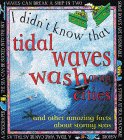
EU English Edition
“Kids in grades 1-3 will enjoy this set of simple yet entertaining facts about tidal waves: from underwater volcanic action to tidal action and ocean problems, this packs in details about tidal waves and their effects on human habitation with over 30 pages including a glossary and bright photos set against black pages.”
“Landslides and Tsunamis”
Barbara Keating, Christopher Waythomas &
Alastair Dawson
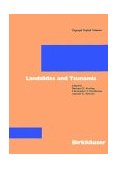
EU English Edition
“The study of tsunamis has been shifting away from theoretical modeling of tsunami source, wave propagation and runup toward multidisciplinary investigations, with an emphasis on field studies. This collection of papers highlights the many approaches being utilized to study landslides and tsunamis.”
“Caribbean Tsunamis:
A 500-year History from 1498 – 1998″
Karen Fay O`Loughlin, James F. Lander (Editor)

EU English Edition
“In the past 500 years, the Caribbean region has had devastating tsunamis causing incalculable damage. It is an area of relatively high seismicity, and although tsunamis are not the chief natural hazard, they have the potential to produce catastrophic regional disasters.
“Today the necessity for awareness is of paramount importance. Tectonic forces continually build stress – until the inevitable release of strain that may trigger a tsunamigenic earthquake. The lack of a major tsunami in the past 57 years is due to a relative lack of relief of built-up energy, and the potential extent of the stress release grows as time elapses. The long period without relief of seismic stress buildup only increases the ominous threat of a devastating tsunami that could result from a sudden seafloor cataclysm.
|
|
The links below are to pages that will give you more information on tsunami – the giant tidal waves that can be caused by undersea earthquakes, volcanoes, landslides, and, as it has recently been realised, by the impacts of asteroids, comets and meteorites in the oceans. Their incredible destructive power has been responsible for the sweeping away of many coastal towns, villages, and inundating huge landmasses throughout history and prehistory.
Following tsunami there is often very little evidence left for future archæologists to discover, and it is highly probable that much of the evidence of civilisation near coastal areas in prehistoric times has simply been wiped away by these incredible forces of nature.
One recent study has discovered that, according to radiocarbon dating of sediments from the area, a ‘giant tsunami’ hit the eastern coast of Scotland in 5,800 BC. Stone tools found in the sand off Inverness showed that the waves hit the area without warning following a landslide off Storegga in north-west Norway.
Professor Smith, of the Department of Geography at Coventry University, told
BBC News Online:
“It looks as if those people were happily sitting in their camp when this wave from the sea hit the camp. Professor Smith of the department of Geography at Coventry University told BBC News Online. We’re talking about two, three or four large waves followed by little ones, that would have been 5-10 metres high. These waves do strike with such force that they are very destructive. It’s like being hit by an express train’.”
A little further south, on Moel Tryfan in North Wales, the mashed and mangled remains of marine molluscs (sea-shells) have been found in so-called ‘Ice-Age drift deposits’ supposedly left there when the ice-sheets melted and retreated back towards the North Pole. But the composition of the supposed ice-sheet deposits told another story.
In their book “Cataclysm: Compelling Evidence of a Cosmic Catastrophe in 9,500 BB”, an academic study of the evidence suggesting that the flood myths of ancient times were based on archaic memories of a ‘real global tsunami’, or ‘deluge’, and which challenges the orthodox interpretation of geological history descending from the notions of a Pleistocene Ice Age theorised by Louis Agassiz in the 1820s, authors D. S. Allan and J. B. state:
“Eroded and fragmentary shells occur within the ‘drift’ deposits on Moel Tryfaen, a mountain in North Wales rising 1,300ft (400m) above sea level. Perplexingly the species represented include not only northern but also temperate and southern forms adapted to very varied habitats. Some required deep and others shallow water, some sandy and others muddy water, and some were peculiar to shingly and others to a bare rocky environment.
In stating that ice could never have brought together so varied a molluscan assemblage as this, it is hardly necessary to add that water could have – in which case the enveloping drift’ deposits must have been similarly water-borne.”
In fact many of the ‘peculiarities’ conventionally attributed to an Ice Age simply could not have been created by the supposed advance and retreat of ice-sheets. Yet, if the many and various ‘flood-myths’ of antiquity, which have been passed down through millennia in the oral traditions of peoples worldwide, are based on true recollections of an ‘archaic deluge’, a catastrophic mega-tsunami could well have produced ALL of the phenomena now attributed to an Ice Age.
These would include:
-
the global distribution of ‘erratic boulders’ – especially in the latitudes which even the die-hard glaciologists admit were not covered with ice-sheets …
-
the multi-zone distribution of flora, fauna and marine life-forms in the composition of so-called ‘glacial drift’ in areas where no ice-sheets are even claimed to have existed …
-
and also in the pitiful conglomerations of broken and twisted remains of animals, birds, fish, trees and plants, pebbles, dirts and clays which can be found in caves and rock crevices in many areas around the world – not to mention the remains of whales and other sea creatures found on mountaintops – irrespective of theorised Pleistocene ice-sheet coverage …
NONE of these supposed ‘Ice Age Peculiarities’ could have been achieved solely by the action of Ice moving horizontally across hilly terrains. The nature of Ice is such that it cannot move uphill, and, as recent scientific surveys have concluded that there were never any huge mountains at the North Pole for ice-sheets to have slid down, ONLY the turbulent waters of mega-tsunami could have brought together such jumbles of life-forms, and forcibly jammed them into the small, tight places we find them today …
Was there really an Ice Age?
Or are the Deluge Traditions and Flood Myths of antiquity based on a sounder ancient science:
Tsunami
One of the best resources for understanding the
December 2004 Tsunami tragedy is the
Sydney Morning Herald’s
Interactive Tsunami Map
Official Tsunami Monitoring Centres :
International Tsunami Information Centre
Yuzhno-Sakhalinsk Tsunami Warning Center
National Geophysical Data Center – Tsunami Database
NOAA Tsunami Research Center
FEMA Fact Sheet: Tsunami
West Coast & Alaska Tsunami Warning Center
–
Latest Tsunami Bulletin
–
Pacific Tsunami Warning Center
–
Latest Tsunami Bulletin
–
Recorded Recent Tsunami
Below are a selection of recent stories from our
News Headlines Archive
Below those are newer 2009 stories in latest date order
…
“The great flood of 1607”
January 30, 2007, BBC Bristol, England:
“Four hundred years ago, in the reign of James I of England, a disaster hit the south west of the country, as a huge surge of water coursed up the Bristol Channel – covering 200 square miles of land with water and killing 2,000 people.
|
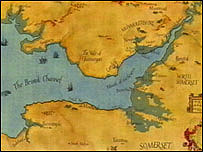
BBC Bristol
Blue shading shows flooded areas
|
|
Eyewitness accounts of the great flood of 30 January 1607 tell of ‘huge and mighty hills of water’ advancing at a speed ‘faster than a greyhound can run’ and only receding 10 days later.
The flood reached a speed of 30mph and a height of 25ft.
|
It swept up to four miles inland in the Bristol area, north Devon, Pembrokeshire, Glamorgan, Monmouthshire and Cardiff – and up to 14 miles inland in low-lying parts of Somerset. But it is still not certain exactly what sparked the disaster which killed so many.
For centuries it was thought high tides and severe storms were to blame, a theory accepted by Dr Kevin Horsburgh from the Proudman Oceanographic Laboratory in Liverpool, who said a massive storm surge, formed by a combination of high tides and hurricane winds, may have been to blame.
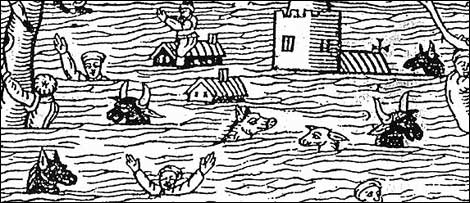
BBC Bristol
But a tsunami theory was put forward by experts from Bath and Australia in 2004, supported by evidence of deposits of sand, pebbles and shell at various locations around the Severn Estuary where flood waters swept in, including Hill in South Gloucestershire.
It’s believed these deposits may have been brought in from the open ocean.”
[Full Story]
“Anniversary of 1607 killer wave”
January 30, 2007, BBC News Online, UK:
“A suspected tsunami in the Bristol Channel which killed 2,000 people happened 400 years ago on Tuesday.
Experts believe severe flooding on 30 January 1607 in south west England and south Wales was caused by a tsunami – and not a storm surge or high tides. It is estimated 200 square miles (520 sq km) of land were covered by water.
Simon Hasslett from Bath Spa University said there was currently no tsunami warning system in place. He said the research was important for informing coastal and risk management plans.
The flood of 1607 has been described by experts as the worst natural disaster to hit Britain. Eyewitness accounts of the disaster told of ‘huge and mighty hills of water’ advancing at a speed ‘faster than a greyhound can run’.”
[Full Story]
Below are a selection of 2009 stories from our
News Headlines Archive
November 03, 2009, The New York Times, USA:
“The massive eruption of the Thera volcano in the Aegean Sea more than 3,000 years ago produced killer waves that raced across hundreds of miles of the Eastern Mediterranean to inundate the area that is now Israel and probably other coastal sites, a team of scientists has found.
The team, writing in the October issue of Geology, said the new evidence suggested that giant tsunamis from the catastrophic eruption hit ‘coastal sites across the Eastern Mediterranean littoral’.
Tsunamis are giant waves that can crash into shore, rearrange the seabed, inundate vast areas of land and carry terrestrial material out to sea.
A map showing the effects of a tsunami said to have been cause by the
eruption of the Thera volcano more that 3,000 years ago
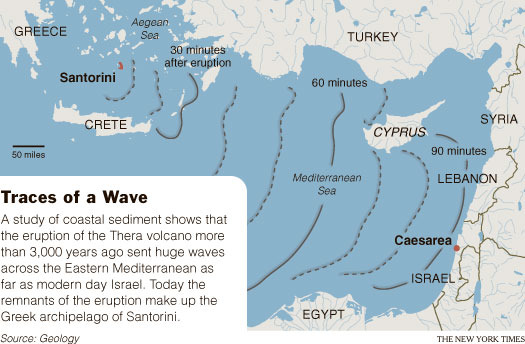
Source: Geology / The New York Times
The region at the time was home to rising civilizations in Crete, Cyprus, Egypt, Phoenicia and Turkey.
For decades, scholars have suggested that the giant eruption, just 70 miles from Crete, might have brought about the mysterious collapse of Minoan civilization at the peak of its glory.
The remnants of Thera’s eruption today make up a circular archipelago of volcanic Greek isles known as Santorini.”
[Full Story]
October 26, 2009, The Jerusalem Post, Israel:
“Even though Israel is situated on the edge of a sea and not an ocean, it too could be hit by tsunamis – massive waves and flooding caused by underwater earthquakes – that have devastated parts of Asia in recent years.
So says Dr. Beverly Goodman, a geo-archaeological researcher at the University of Haifa’s Charney School of Marine Sciences, who just published a study that exposed evidence of four tsunami events on the coast of Caesarea..
‘There is a likely chance of tsunami waves reaching the shores of Israel’, Goodman said on Sunday. ‘Tsunami events in the Mediterranean do occur less frequently than in the Pacific Ocean, but our findings reveal a moderate rate of recurrence.’
The Talmud itself mentions a tsunami between Caesarea and Yavne that occurred on December 12 in the year 115 CE after a major earthquake hit northwest Syria.
Goodman exposed the geological evidence serendipitously, as she had originally intended to help others research Caesarea’s ancient post and offshore shipwrecks.
‘We expected to find the remains of ships but were surprised to reveal unusual geological layers, the likes of which we had never seen in the region before. We began underwater drilling assuming that these are simply local layers related to the construction of the port.’
‘However, we discovered that they are spread along the entire area and realized that we had found something major’, she explained.”
[Full Story]
October 26, 2009, Arutz Sheva, Israel:
“New geo-archaeological research at the Leon H. Charney School of Marine Sciences at the University of Haifa has exposed evidence of four tsunami events on the coast of Caesarea, between Tel Aviv and Haifa.
In a statement released by the university on Sunday, Dr. Beverly Goodman, who headed the research, said, ‘We expected to find the remains of ships, but were surprised to reveal unusual geological layers the likes of which we had never seen in the region before.’.
Using Carbon-14 dating and OSL (optically stimulated luminescence), Dr. Goodman found evidence of tsunami events in 1500 BCE, 100-200 CE, 500-600 CE, and 1100-1200 CE.”
[Full Story]
October 12, 2009, Stuff, New Zealand:
“About 500 years ago New Zealand was hit by the mother of all tsunamis.
A wave of water 25 metres high swept ashore from the north. That’s as high as an eight-storey building and 12 times bigger than the one that hit Samoa the other day. The water surged inland up to a kilometre and up to a height of 32 metres. It was still 10 metres high as it swelled through Cook Strait..
How do we know about this? Because archaeologist Bruce McFadgen has spent years scouring our coasts and reading scientific reports.
He and other scientists have found evidence of the big tsunami from Northland and Bay of Plenty to Nelson.
Wellington there are tsunami- generated marine gravel and rocks, pumice, seashells, driftwood and debris on Kapiti Island, in Palliser Bay and on D’Urville Island.
More evidence comes from eroded riverbanks, seaside cuttings, from dug holes, drilled cores and from buried Maori settlements. The evidence for a big tsunami is overwhelming.”
[Full Story]
October 09, 2009, Live Science, USA:
“The volcanic explosion that obliterated much of the island that might have inspired the legend of Atlantis apparently triggered a tsunami that traveled hundreds of miles to reach as far as present-day Israel, scientists now suggest.
The new findings about this past tsunami could shed light on the destructive potential of future disasters, researchers added.
The islands that make up the small circular archipelago of Santorini, roughly 120 miles (200 km) southeast of Greece, are what remain of what once was a single island, before one of the largest volcanic eruptions in human antiquity shattered it in the Bronze Age some time between 1630 B.C. to 1550 B.C.
Speculation has abounded as to whether the Santorini eruption inspired the legend of Atlantis, which Plato said drowned in the ocean.
Although the isle is often regarded as just an invention, the explosion might have given rise to the story of a lost empire by helping to wipe out the real-life Minoan civilization that once dominated the Mediterranean, from which the myth of the bull-headed ‘minotaur’ comes.”
[Full Story]
September 30, 2009, ABC Science News, Australia:
“Scientists say the tsunami that devastated the islands of Samoa, American Samoa and Tonga was the result of a shallow rupture in the earth’s crust.
The earthquake, which was measured as high as 8.3 on the Richter scale, occurred 190 kilometres southwest of American Samoa.
A map showing the effects of an 8.3-magnitude earthquake and its
resultant tsunami on Samoa and American Samoa
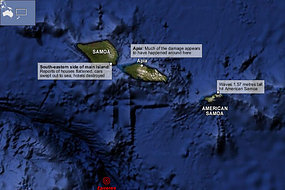
Source: Google
Gary Gibson, a senior seismologist at Environmental Systems and Services in Melbourne, says the region experiences several magnitude 7 earthquakes each year, but a magnitude 8 is quite rare
‘The earthquake had a magnitude of about 8, which corresponds to a rupture within the earth that may be 200 to 300 kilometres long, with a depth of 100 to 200 kilometres, with one side of the fault moving four to seven metres relative to the other’, says Gibson.
He says the energy released in the earthquake was approximately one-thirtieth the size of the Boxing Day 2004 earthquake near the island of Sumatra, Indonesia.”
[Full Story]
September 30, 2009, BBC News, UK:
“A tsunami triggered by a strong quake in the South Pacific has killed more than 100 people in several islands.
At least 77 people were reported dead in Samoa, more than 25 in American Samoa and at least six in Tonga.
A map of the Pacific region affected by the September 30th tsunami
showing the epi-centre of the undersea quake that triggered the tsunami
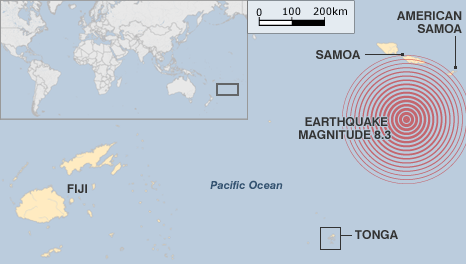
Credit: Ian Shennan, University of Durham
Residents and tourists fled to higher ground as whole villages were destroyed. Boats were swept inland and cars and people out to sea.
The 8.3-magnitude quake struck at 1748 GMT on Tuesday, generating 15ft (4.5m) waves in some areas of the islands.
The Samoa islands comprise two separate entities – the nation of Samoa and American Samoa, a US territory. The total population is about 250,000.
A general tsunami warning was issued for the wider South Pacific region but was cancelled a few hours later”
[Full Story]
July 21, 2009, Live Science, USA:
“The threat of a devastating tsunami hitting the U.S. West Coast might be higher than previously thought, scientists say, based on a new study of earthquake faults off the coast of Alaska
Tsunamis are often triggered by earthquakes, as was the case with the 2004 Indian Ocean tsunami, which was sparked by the 9.3-magnitude Sumatra-Andaman subduction quake in the same ocean. The tsunami killed nearly a quarter of a million people.
University of Utah geologist Ron Bruhn stands atop a section of sediments
on Alaska’s ‘Forgotten Coast’ east of Cape Yakataga.
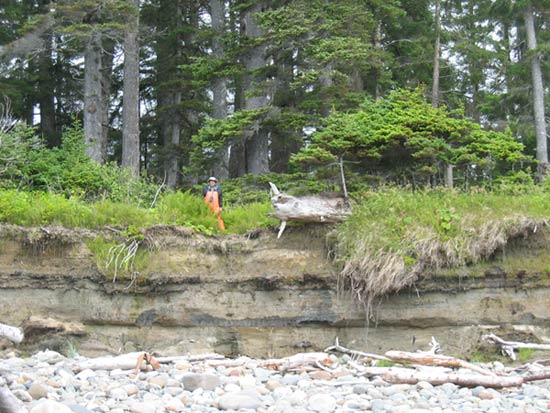
Credit: Ian Shennan, University of Durham
A study of such sediments by Bruhn and colleagues found that prehistoric earthquakes in Alaska were bigger than a devastating 1964 quake that generated a tsunami, suggesting greater future tsunami threats for the U.S. West Coast.
Tsunamis are often triggered by earthquakes, as was the case with the 2004 Indian Ocean tsunami, which was sparked by the 9.3-magnitude Sumatra-Andaman subduction quake in the same ocean. The tsunami killed nearly a quarter of a million people.
The new research suggests that future tsunamis could reach a scale far beyond that suffered in a 1964 tsunami generated by the great 9.2-magnitude Alaskan earthquake — ‘the most devastating seismic sea wave to impact the northwestern coast of the U.S. in historical time’, said study team member Ron Bruhn, a geologist at the University of Utah.
That tsunami killed about 130 people, according to official records: 114 in Alaska and 16 in Oregon and California, including several who heard it was coming and went down to the coast to watch.”
[Full Story]
May 03, 2009, BBC Science News, UK:
“A huge wave crashed into the New York City region 2,300 years ago, dumping sediment and shells across Long Island and New Jersey and casting wood debris far up the Hudson River.
The scenario, proposed by scientists, is undergoing further examination to verify radiocarbon dates and to rule out other causes of the upheaval.
Atlantic tsunamis are rare, but could be triggered
by submarine landslides
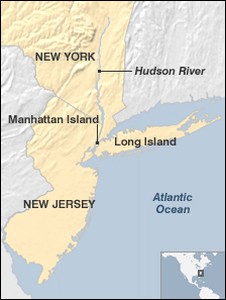
BBC Science News
Sedimentary deposits from more than 20 cores in New York and New Jersey indicate that some sort of violent force swept the Northeast coastal region in 300BC. It may have been a large storm, but evidence is increasingly pointing to a rare Atlantic Ocean tsunami.
Steven Goodbred, an Earth scientist at Vanderbilt University, said large gravel, marine fossils and other unusual deposits found in sediment cores across the area date to 2,300 years ago.”
[Full Story]
April 23, 2009, PhysOrg, USA:
“Up to 30,000 residents and tourists could be under threat from a newly discovered tsunami risk in the Caribbean, according to experts in disaster risk management.
The heavily populated coast of Guadeloupe will have little warning if a tsunami is triggered by the collapse of a volcano on the nearby island of Dominica.
Detailed view of the c. 1 million tonne block, being undercut by
wave erosion, on the northern margin of Morne aux Diables volcano.
Tension cracks on the inland side of the block are clearly visible.
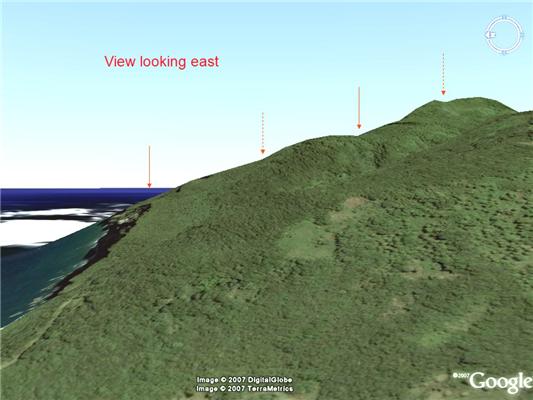
DigitalGlobe, TerraMatrics, Google
A team of geologists, led by Dr Richard Teeuw from the University of Portsmouth, have discovered that a flank of the volcano Morne aux Diables (“Devils’ Peak”) shows signs of collapse and if so, a million-ton chunk of rock could crash into the sea, producing tsunami waves up to almost 3 metres (10 feet) high.
Such a rock fall could also weaken three million tones of rock upslope, potentially resulting in much larger landslides and waves of up to five metres.
Dr Teeuw said: ‘It’s not a case of if this landslide and tsunami will happen, but when. The trigger will probably be a major earthquake, occurring after the heavy rain and coastal erosion of the hurricane season. It could happen in a hundred years or it could happen next week.’“
[Full Story]
April 16, 2009, New Scientist, UK:
“The odds of encountering a tsunami kicked up by an asteroid strike have just plummeted. Best to hope, though, that you’re not underneath the almighty splash such an impact could create.
Small impactors hit us far more frequently than larger ones: a 200-metre asteroid hits Earth about every 10,000 years on average, while 10-kilometre objects like the one that probably killed off the dinosaurs strike every 100 million years. Much of the worry over asteroids has centred on the more likely event of a smaller one splashing down in the ocean and triggering a powerful tsunamiMovie Camera.
Now simulations to be presented at an asteroid hazard conference in Granada, Spain, this month suggest that small asteroids do not after all pose a major tsunami threat.
Galen Gisler of the University of Oslo, Norway, and colleagues used software originally written to simulate the effects of underwater nuclear explosions to hurl a virtual 200-metre asteroid into an ocean 5 kilometres deep.
The impact initially sends waves hundreds of metres high spreading from the impact site. However, the very height of the waves makes them prone to collapse even in very deep water: they start breaking immediately, like ordinary waves on a beach.”
[Full Story]
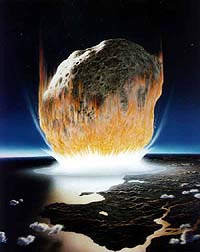
|
|
To understand why this News Page is sometimes late here is some information about Fibromyalgia
if you would like to support our marine archaeology research
The Morien Institute
Research Projects
please send us a book

from our Wish List
Ancient Mysteries
Bookshoppe
for a wide selection of
books that challenge
orthodox views of
prehistory on
our planet :
“Eden in the East: The Drowned Continent of Southeast Asia”
Stephen Oppenheimer

EU English Edition
“A book that completetly changes the established and conventional view of prehistory by relocating the Lost Eden – the world’s 1st civilization – to SouthEast Asia. At the end of the Ice Age, SouthEast Asia formed a continent twice the size of India, which included Indochina, Malaysia, Indonesia and Borneo.
The South China Sea, the Gulf of Thailand and the Java sea, which were all dry, formed the connecting parts of the continent. Geologically, this half sunken continent is the Shunda shelf or Sundaland.
He produces evidence from ethnography, archaeology, oceanography, from creation stories, myths and sagas and from linguistics and DNA analysis, to argue that this founder civilization was destroyed by a catastrophic flood, caused by a rapid rise in the sea level at the end of the last ice age.”
“Red, Earth, White Lies: Native Americans & the Myth of Scientific Fact”
Vine Deloria

EU English Edition
“Leading Native American scholar and author of the best-selling books God Is Red and Custer Died for Your Sins, Vine Deloria, Jr., addresses the conflict between mainstream scientific theory about the world and the ancestral worldview of Native Americans. Claiming that science has created a largely fictional scenario for American Indians in prehistoric North America, Deloria offers an alternative view of the continent’s history as seen through the eyes and memories of Native Americans.
“The World Almanac and Book of Facts”
Ken Park (Editor)
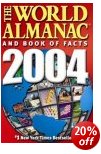
EU English Edition
extracts from pages
in the book:
“… systems can drive ocean water inland and cause significant flooding. Coastal floods can also be produced by sea waves called tsunamis, sometimes referred to as tidal waves: these waves are produced by earthquakes or volcanic activity
“… of the volcano collapsed to 1,000 ft below sea level, sinking most of the island and killing over 3,000. A tsunami (tidal wave) generated by the collapse killed more than 31,000 people in Java and Sumatra, and eventually reached England.”
“Furious Earth: The Science and Nature of Earthquakes, Volcanoes, and Tsunamis”
Ellen J. Prager
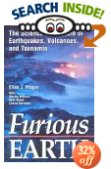
EU English Edition
from the back cover:
“The Science Behind the Earth’s Most Catastrophic Phenomena. If our planet is a sleeping giant, it slumbers fitfully and awakens in powerful starts. Our familiar landscape bears the scars f hidden forces at work deep beneath it. Furious Earth contains the latest science on these forces and the cataclysmic phenomena they produce – earthquakes, volcanoes, and tsunamis.
Now, hard-won knowledge of these phenomena, gained often in the aftermath of disaster or through dangerous research efforts, is presented here by scientist Ellen Prager with the following experts: Stanley Willaims, Ph.D. Professor of Volcanology, Arizona State University, on volcanoes; Kate Hutton, Ph.D., Seismologist, California State Institute of Technology, on earthquakes; Costas Synolakis, Ph.D., Professor of Civil Engineering, University of Southern California, on tsunamis.”
Japan’s Mysterious Pyramids: YONAGUNI

Do undersea relics near Okinawa offer proof of a sophisticated civilization during the last ice age?
www.historychannel.com
A Further Selection Of Books About:
Tsunami
Tidal Waves
Earthquakes
Volcanoes
|